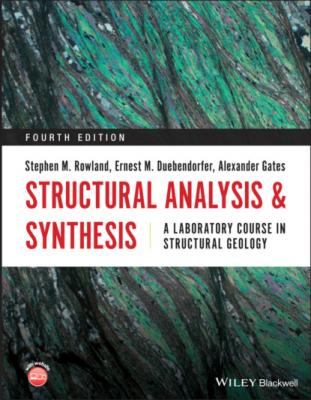ТОП просматриваемых книг сайта:
Structural Analysis and Synthesis. Stephen M. Rowland
Читать онлайн.Название Structural Analysis and Synthesis
Год выпуска 0
isbn 9781119535485
Автор произведения Stephen M. Rowland
Жанр География
Издательство John Wiley & Sons Limited
Figure 2.15 Determination of outcrop pattern of a gently bent surface using structure contours. (a) Attitude of a gently folded marker bed at three points on a topographic map. (b) Interpolation of elevations between points of known elevation. (c) Structure‐contour map of a gently folded bed. (d) Structure‐contour map superimposed on topographic base. (e) Inferred outcrop pattern of marker bed.
Determining Exact Attitudes from Outcrop Patterns
Because the strike of a plane is a horizontal line, any line drawn between points of equal elevation on a plane defines the plane's strike. Figure 2.16a is a geologic map with two rock units, Formation M and Formation X. The contact between these units crosses several topographic contours. To find the strike of the contact, a straight line is drawn from the intersection of the contact with the 1920‐ft contour on the west side of the map to the intersection of the contact with the 1920‐ft contour on the east side of the map (Figure 2.16b). The strike of this contact is determined to be 079° (N79E), as measured directly on the geologic map using a protractor.
Using the rules of Vs, the outcrop pattern in Figure 2.16a indicates that the beds dip toward the south. To determine the exact dip, draw a line that is perpendicular to the strike line from another point of known elevation on the contact. In Figure 2.16c, a line is drawn from the strike line to a point where the contact crosses the 1680‐ft contour. The length of this line (h) and the change in elevation (v) from the strike line to this point yield the dip δ with the following equation (Figure 2.16d):
Figure 2.16 Technique for determining the orientation of a plane from its outcrop pattern. (a) Contact between Formation M and Formation X on a topographic map. (b) The line connecting points of equal elevation defines the strike. (c) A perpendicular is drawn to a point of contact at a different elevation. (d) Dip angle δ is found from tan δ = v/h.
The solution to this example is:
This method for determining attitudes from outcrop patterns can only be used if the beds are planar.
Figure 2.17 shows the Neogene (Miocene and Pliocene) units of the Bree Creek area. Straight lines have been drawn connecting points of known elevation on the bottom contact of the unit Tr. The strike, measured directly on the map with a protractor, is 344° (N16W), and the dip is 11°NE as determined by:
Determining Stratigraphic Thickness in Flat Terrain
If the attitude of a rock unit is known, it is usually possible to determine its approximate stratigraphic thickness from a geologic map. If a unit is steeply dipping, and if its upper and lower contacts are exposed on flat or nearly flat terrain, then the thickness is determined from the trigonometric relationship.
Figure 2.17 Neogene units in the Bree Creek area. Tg = Conglomerate; Thd = Sandstone; Tr = Tuff.
where t is stratigraphic thickness, h is horizontal thickness (map width), and δ is dip (Figure 2.18).
Figure 2.18 Trigonometric relationships used for determining stratigraphic thickness t in flat terrain from dip δ and map width h.
Determining Stratigraphic Thickness on Slopes
The thickness of layers exposed on slopes may be determined trigonometrically if, in addition to dip δ and map width h, the vertical distance v (i.e. difference in elevation) from the base to the top of the layer is known. Figure 2.19a shows a layer and the slope dipping in the same direction. Relevant angles are added in Figure 2.19b, from which the following derivation is made:
This relationship applies to situations where bedding dips more steeply than topography and both dip in the same direction (right‐side example in Figure 2.20). Similar trigonometric derivations can be used to show that in situations where bedding dips more gently than topography and both dip in the same direction (left‐side example in Figure 2.20), the equation is:
Where bedding and topography dip in opposite directions (middle example of Figure 2.20) the equation is:
Figure 2.19 Determining stratigraphic thickness t on slopes. (a) Lengths h and v and dip angle δ are needed to derive t. (b) Geometry of derivation.

